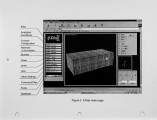| OCR Text |
Show accuracy, he can manually choose other more sophisticated models. The details of mathematical modeling were mentioned in the references [1] and [2]. 3.3. Graphical User Interface Figure 2 shows the main page of if-Diss. By simply following the menu in the left side frame, users can process the data input interactively. W h e n a user selects one of the menu button, a new window comes up on the screen, prompting the user to input necessary data. Since most of the numerical conditions applicable to common industrial furnaces have already been prepared as default, the user has to input only a few data specific to the particular problem. A brief description of the functions of if-Diss G U I is made in the following section. 3.3.1. Analytical conditions First, users specify a solver for CFD analysis , calculation method and units used for parameters. The selection is valid through all the if-Diss pages. if-Diss is basically applicable to a rectangular or cylindrical shape. Curved ceilings such as domes and crowns are available as well. 3.3.2. Furnace configurations Users can choose types and functions of furnaces from a submenu, which is categorized depending on the type of furnace. W h e n a user select the type of furnace, the input window appears on the screen, prompting users to set minimum necessary input conditions. Dimensions of the furnaces are specified easily by mouse handling as shown in Figure 3. It is also possible to specify the dimensions by typing numbers directly. The size and allocations of material(s) to be heated, bumer(s) and flue(s) can be set in a similar manner. 3.3.3. Burner and flame model There are a number of methods to model flames. if-Diss' default model is a heat release distribution model, which is used to simulate heat transfer phenomenon rather than combustion. Figure 4 shows the concept of the model. The model distributes heat release rate to each numerical cell downstream the burner as a heat source. The area of distributing heat release and the rate of distribution are determined by formulations based on empirical approach. The model requires the physical size and velocity at the burner tile, flame length and flame width as input data. This feature is suitable for furnace designers to select burners from the commercialized burner catalog. Other flame models can be selected as well on this page. 3.3.4. Physical property Physical properties of combustion gases and wall structures consisting of refractories, insulators and metals are stored in the material database. Figure 5 shows the material database window. W h e n a user selects one of the materials, then thermal data stored in the database appears on the screen, ready to be applied to each layer of a furnace wall. User can set and add new material data, which will be added to the database by pressing "Add" button. 4 |



















